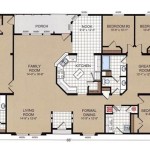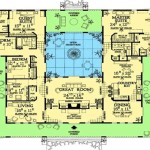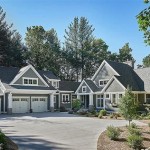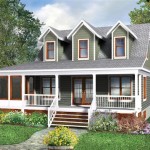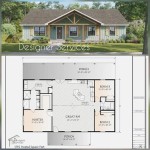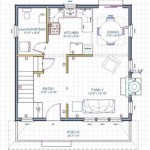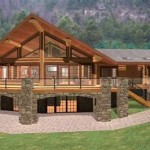Garage On Side Of House Plans: A Comprehensive Guide
The placement of a garage significantly impacts a home's curb appeal, functionality, and overall value. A garage positioned on the side of a house offers certain advantages over front-facing or rear-facing alternatives. Understanding the nuances of garage on side of house plans is crucial for homeowners considering this architectural style.
These plans typically involve integrating the garage into the side elevation of the house, often extending from the main structure. This configuration can free up the front façade for landscaping and enhanced aesthetic appeal, improve backyard privacy, and potentially provide easier access to the backyard for storage of recreational equipment or yard maintenance tools.
However, implementing such a design requires careful consideration of lot size, zoning regulations, driveway access, and the overall architectural style of the house. This article delves into the key aspects of garage on side of house plans, exploring their benefits, challenges, and design considerations.
Advantages of Garage on Side of House Plans
One of the primary benefits of locating a garage on the side of a house is the improved aesthetic appeal of the front façade. A front-facing garage can often dominate the view of the house from the street, detracting from its architectural features and landscaping. By moving the garage to the side, the front of the house becomes the focal point, allowing for a more welcoming and visually pleasing presentation.
Side-entry garages can also significantly enhance backyard privacy, particularly if the garage extends along a property line. This creates a natural barrier, shielding the backyard from street views and potentially reducing noise. This configuration is especially beneficial for properties situated on busy streets or those seeking a more secluded outdoor living space.
Furthermore, a side garage often provides more convenient access to the backyard. Many homeowners use their garages for storing lawnmowers, gardening tools, and other outdoor equipment. A side garage simplifies the process of moving these items between the garage and the backyard, eliminating the need to navigate through the house. Some designs incorporate a side door in the garage that opens directly into the backyard, further enhancing this accessibility.
Another key benefit is the potential for increased interior space flexibility. Front-facing garages often directly abut the living space, limiting design options. Side garages, especially those extending further back from the main house footprint, can allow for more open floor plans and versatile room arrangements in the main living areas. The space previously allocated to garage access in the front of the house can be repurposed for living rooms, dining rooms, or even home offices.
Design Considerations for Garage on Side Of House Plan
Planning a garage on the side of a house involves careful consideration of various factors to ensure a functional, aesthetically pleasing, and code-compliant design. Lot size and shape are paramount. A narrow lot might not accommodate a side garage without encroaching on setbacks or creating an overly long driveway. Similarly, an irregularly shaped lot may present challenges in integrating the garage seamlessly into the existing landscape.
Zoning regulations also play a crucial role. Local ordinances often dictate setback requirements (the distance a structure must be from property lines), maximum building height, and allowable lot coverage. These regulations can significantly impact the size and placement of the garage. It is essential to consult with the local planning department to ensure compliance with all applicable zoning laws before beginning the design process.
Driveway design is another critical aspect. A long driveway leading to a side garage can consume a significant portion of the front yard and potentially affect the curb appeal if not planned carefully. Considerations should include the driveway's gradient, width, and turning radius to ensure safe and convenient vehicle access. The driveway material should also complement the overall aesthetic of the house and landscaping.
The architectural style of the house should be carefully considered when designing a side garage. The garage should seamlessly integrate with the existing structure, both aesthetically and structurally. Matching the garage's roofline, siding, and trim to the main house is crucial for creating a cohesive and harmonious design. The garage doors should also be chosen to complement the house's style, and should not detract from the overall aesthetic.
Furthermore, the interior layout of the house should be considered. A side garage can often be integrated with the house through a mudroom or entryway, providing a convenient transition space between the garage and the living areas. This space can be designed to accommodate storage for coats, shoes, and other items, helping to keep the house tidy and organized. The location and size of this entryway will significantly impact the usability and flow of the house.
Challenges of Garage on Side of House Plans
While side garages offer numerous benefits, they also present certain challenges. One of the most significant challenges is the potential for a long driveway. If the house is situated far back from the street, a side garage will necessitate a long driveway that extends along the side of the house. This can consume a significant portion of the front yard and may be aesthetically unappealing if not carefully designed.
Another potential challenge is the increased construction cost. Building a side garage often requires more extensive site preparation, including grading and excavation, particularly if the lot has a significant slope. The longer driveway also adds to the overall cost of the project. Furthermore, integrating the garage into the side of the house may require more complex structural engineering, further increasing the construction expenses.
Integrating a side garage into an existing house can pose additional challenges. Retrofitting a garage onto the side of an existing structure may require significant modifications to the house's foundation, roofline, and exterior walls. This can be a complex and costly undertaking, and may not be feasible in all cases. A structural engineer should be consulted to assess the feasibility of the project and to ensure that the modifications are structurally sound.
Drainage and grading are also important considerations. A long driveway can impede the flow of rainwater, potentially leading to water accumulation around the house's foundation. Proper drainage systems should be installed to ensure that rainwater is effectively diverted away from the house. The grading of the lot should also be carefully considered to ensure that water flows away from the house and does not pool in the driveway or around the garage.
Another potential challenge is the reduced natural light in the adjacent rooms. If the side garage blocks sunlight from reaching the windows of adjacent rooms, it can darken these spaces and make them feel less inviting. This can be mitigated by incorporating windows or skylights into the garage design to allow natural light to penetrate the adjacent rooms. The placement and size of these windows should be carefully considered to maximize the amount of natural light entering the rooms.
Landscaping also plays a crucial role in the success of a side garage design. Careful landscaping can help to soften the visual impact of the garage and integrate it seamlessly into the surrounding environment. Trees, shrubs, and other plants can be used to screen the garage from view and to create a more natural and inviting landscape. The landscaping should also be designed to complement the overall aesthetic of the house and to enhance its curb appeal.
Ultimately, the decision of whether to incorporate a garage on the side of a house depends on a variety of factors, including lot size, zoning regulations, budget constraints, and personal preferences. A thorough assessment of these factors is essential for making an informed decision that aligns with the homeowner's needs and goals. Consulting with an architect or experienced building contractor can provide valuable insights and guidance throughout the planning and construction process.

One Story 2 Bedroom New American House Plan With Side Entry Garage And Open Concept Living

Floor Plan Friday 4 Bedroom With Side Garage Activity

Open Concept Home With Side Load Garage 89912ah Architectural Designs House Plans

Best Corner Lot House Plans Floor With Side Entry Garage

Craftsman House Plan With 3 Bedrooms A Side Entry 2 Car Garage 4315

L Shaped House Plans With Side Garages Blog Eplans Com

Best Corner Lot House Plans Floor With Side Entry Garage

House Plans With Rear Entry Garages

Side Entry Garage Home Plans House And More

Farmhouse Home Plan Westwood Side Load Garage Dream Book Plans


